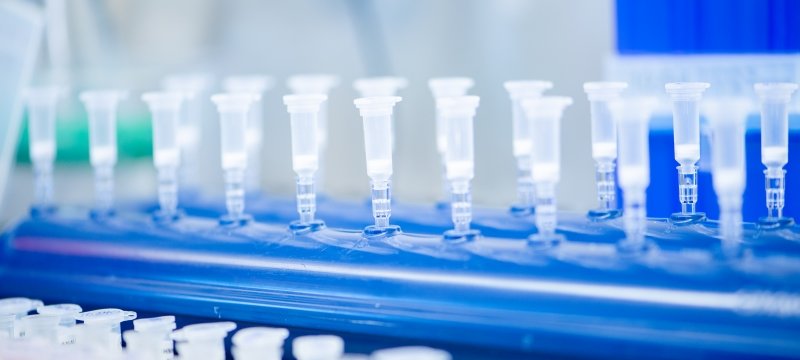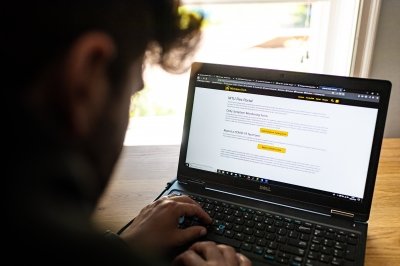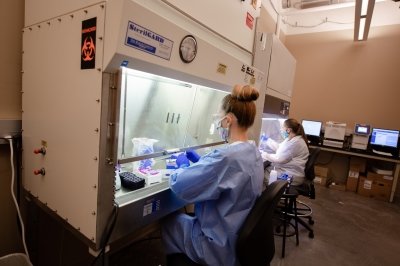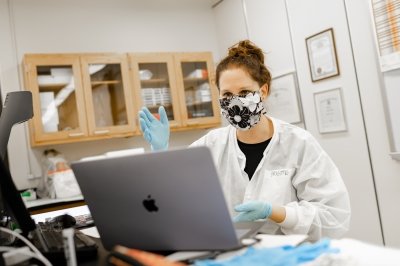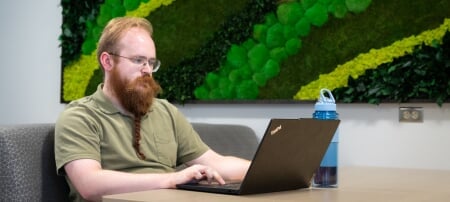MTU Flex Helps Tech Navigate the COVID-19 Pandemic
Early in 2020, the COVID-19 pandemic swept across the world. In March of 2020, Governor Whitmer issued a “Stay Home, Stay Safe” order. Michigan Tech responded with its typical agility and moved to remote instruction, face coverings indoors, and limited personnel on campus. Group gatherings were prohibited, and common areas were closed. Visitors to campus were restricted to essential contractors, and university travel was discontinued. The Department of Biological Sciences, working with the Department of Biomedical Engineering and several other campus departments, began setting up a COVID testing lab.
On May 28, 2020, Michigan Tech initiated Step One of a three-step Return to Campus Plan and entered the final step on July 27, 2020. This marked the introduction of the MTU Flex plan and a transition to a Health and Safety Levels system, known as MTU Flex. These five levels were designed to enable the University to respond quickly and appropriately to COVID on campus and in the community with scientifically informed, practical, and targeted protocols.
The campus remained at Level Three until September 28, 2020, when it moved to Level Four through October 12, 2020, and then back to Level Three. During this time, most instruction remained remote with some limited on-campus classes. Face coverings and daily symptom monitoring were still required, and indoor gatherings remained limited. Some employees could return to campus if their unit decided it was necessary. Only essential travel was permitted, and COVID testing was available on campus through the testing lab.
In November 2020, with COVID surging, the campus moved back to Level Five. By January 2021, the University was able to move to Level Three. At that level, in-person instruction was permitted, although online instruction remained an option. Face coverings and daily symptom monitoring were still required. Employees could come back to campus; visitors were permitted; common areas were mostly open, and travel was permitted. The COVID testing lab continued to offer symptomatic and asymptomatic testing.
In May 2021, Tech moved to Level Two. Face-to-face instruction returned as the norm. Employees came back to campus; common areas were open; visitors were permitted; group gatherings were allowed if they met state rules for numbers, and travel was permitted. Face coverings were still required indoors.
But in September 2021, in response to another COVID surge, the University fell back to Level Three. That only lasted a month, with Tech returning to Level Two late in October.
In February 2022, the campus was able to move to Level One, where face coverings are not required, common areas are open; there are no restrictions on the size of group gatherings; visitors are permitted, and travel operates under normal procedures.
President Rick Koubek wrote in a letter to the campus in February 2022, “With the wide availability of the COVID-19 vaccine, low hospitalization rates, and the accumulated knowledge and processes in place to fight future outbreaks if needed, it is now appropriate to move to longer-term solutions. Thank you for the responsiveness, respect, and collective concern each of you has exhibited over the past two years.”
The MTU Flex team made a special effort to keep students, faculty and staff informed during this time. They sent out weekly emails with updates on the COVID situation and campus response. Having reached Level One, the Flex team disbanded and handed this healthcare issue back to the professionals, including all testing and monitoring.
Michigan Tech Steps Up to Offer COVID Testing for Campus and Community
As the COVID pandemic swept the nation in early 2020, healthcare facilities everywhere quickly ran out of COVID tests. And remote, rural areas like ours were among the hardest hit. Michigan Tech quickly stepped up to help meet the need.
By mid-April 2020, Tech had a testing lab set up and operating. Partnering with local hospitals, the lab began testing for possible COVID infection in the university and community. Initially, the lab could run 40 tests per hour on two machines with six staff.
Faculty from all over Michigan Tech contributed their expertise. The interdepartmental effort was led by Caryn Heldt, professor of chemical engineering, and David Dixon, director of biological laboratory operations. Their team included Biological Sciences faculty Steve Techtmann, Ebenezer Tumban, Karyn Fay, Claire Danielson, Brigitte Morin, and Guiliang Tang; College of Forest Resources and Environmental Sciences faculty and staff Kristin Brzeski, Carsten Kulheim and Jennifer Sanders; Sean Kirkpatrick, chair of Biomedical Engineering, and Julie Seppala, associate vice president for finance.
State Rep. Greg Markkanen and Senator Ed McBroom, who advocated for test sites in the UP., praised Tech for its quick response. “The Michigan Tech testing facility eases the strain on small communities’ health resources,” said Markkanen. He called Michigan Tech’s response to the need for a testing lab a “Herculean effort.”
The test to confirm a COVID-19 case has two parts. It relies on finding the genetic fingerprint of the virus among the skin cells, mucus, and microbes collected by a nasal swab. The genetic code is pulled out of the sample by RNA extraction. Then the extracted sample is run through a polymerase chain reaction (PCR) machine that amplifies the genetic code. Using reagents, the PCR machine produces a positive or negative test result.
The lab started small but expanded quickly to meet the growing demand for testing. A $142,359 grant from the Portage Health Foundation allowed the university to buy a KingFisher Flex System RNA extractor that nearly doubled the lab's sampling capacity while lowering staffing requirements.
Tech’s testing lab operated for 20 months, ultimately expanding its capability to do 50 tests an hour on one machine with only two staff. Over its lifetime, the lab ran more than 40,000 COVID tests, ceasing operation when the Western UP Health Department opened its testing facility in the fall of 2021.
In January 2022, Michigan Tech was one of four universities in the state to receive $18.5 million from the Centers for Disease Control and Prevention grant. Tech’s share of the grant was $4.3 million. The funds are being used to improve timely genomic surveillance by expanding sequence generation and analysis and building bioinformatics capabilities including analysis, data processing, storage, sharing, and data interpretation and analytics of the generated sequence data.
Two College of Computing faculty members joined the genomic surveillance team. Dukka KC, associate dean of research and associate professor of Computer Science, and Guy Hembroff, associate professor of Applied Computing and director of the Health Informatics graduate program, are working to develop a robust computational infrastructure and a bioinformatics workflow pipeline for genomic surveillance.
“Michigan Tech continues to be a leader in the Upper Peninsula for providing community resources during the COVID-19 pandemic,” said Caryn Heldt, director of the university’s Health Research Institute. “For 20 months, the university provided community and campus testing for the virus. Now, with support from the state and federal government, we will develop the infrastructure to provide sequencing capacity for state health agencies. We are excited to help the state scale its capacity and continue to support our community in response to the COVID-19 pandemic and in addressing future health threats.”
Michigan Tech’s COVID-19 testing laboratory was recognized in a special tribute on April 30 by both houses of the Michigan Legislature and by Gov. Gretchen Whitmer and Lt. Gov. Garlin Gilchrist II for its contributions to community health and safety.
The special tribute commends the lab for “its rapid implementation at the start of the pandemic with the ability to perform high-volume COVID-19 testing with rapid turnaround results. The lab has had a dramatic and significant impact on the health and health care of residents in the Upper Peninsula of Michigan.”
If you are interested in more details, our previous MLS director and COVID-19 Liason, Karyn Fay has published a five part series in Critical values journal (criticalvalues.org) from July 2022 to November, 2022.
“SERIES: Meeting the Needs of a Rural Community During the COVID-19 Pandemic: The Ups and Downs of Starting a University Based Clinical Lab for COVID-19 Testing, From Idea to Final Completion” in July 2022, August 2022, September 2022, October 2022 and November, 2022.
Teaching Online: A Challenge and an Opportunity
The pandemic struck with a vengeance. All of a sudden, teaching online replaced lecture halls and labs. How did the Biological Sciences faculty deal with that?
For some, it brought new opportunities. For most, it was a challenge. And for a few, it was a horror just to be endured.
Assistant Professor Trista Vick-Majors gave herself a moment to panic. Then, she says, she stopped and made a plan.
“I knew that I could transition most of my materials to either video lectures or online discussion boards in our already-existing online platform—Canvas—which I was already using for the course,” she says. “But the most important piece was going to be communicating with the students, so I did that first. In times of instability, the most important thing is clear communication. I let them know immediately that I was working on the transition and that they would hear from me as soon as I had the details in place. I didn't want them to have to wonder about what was going on.”
Vick-Majors says one of her biggest challenges was transitioning the lab portion of her limnology course. She had been planning to take the class out to do some field work. “Luckily, I was able to find some great online resources that allowed the students to work with real limnological data,” she says. She also used the interactive SimBio program that enabled her to demonstrate ecological principles relevant to the course.
Overall, she feels that the experience helped her better organize her future courses. “I learned that delivery methods need to be adjusted for online learning. Full-length lectures don’t translate well to video, so putting things in more bite-sized pieces is important.”
Vick-Majors sees a valuable place for integrating online learning into the Biological Sciences curriculum. “The flexibility it provides for both teachers and learners can help reach a broader diversity of students,” she says.
Professor Thomas Werner found online teaching extremely nerve-wracking at first. “But I told my students how I felt about it, and they probably felt the same, so we had something in common,” he recalls.
“Zoom wouldn't record some of my lectures,” Werner says. “Zoom would crash when too many people streamed their cameras. My kids were slamming doors all day while I was teaching from the attic.”
Did Werner find any unexpected benefits to teaching online? “Not at all,” he says.
Should teaching be incorporated into the curriculum in the future? “Absolutely not,” Werner replies. And what did he learn from the experience? “That I never want to teach online again.”
Senior Lecturer Brigitte Morin has a different take on it. “This was hard. This was messy. This was imperfect,” she says. “But to ignore the opportunities rooted in hardship is to pass up the chance to evolve.”
So evolve she did. With her biggest classes—anatomy and nutrition—Morin realized that she could not interact with students effectively online. So she chose to prerecord lectures and provide a schedule of assignments using iClickers, an online platform that allows students to text questions and types numerical values in answers.
With the online format, though, she found she did lose touch with students. “And I don’t like that,” she says.
Things went better with her Medical Laboratory Science classes. “These are students I know well,” she explains. “I was able to do synchronous Zoom classes, where we are both on the screen doing live dialogues. We learned how to use breakout rooms together, and they’d offer me technical tidbits when I struggled. The engagement was easier to do.”
Sometimes Morin’s online efforts flopped. “I wanted to adapt a lesson I normally do in person with students using sticky notes,” she says, “so I tried using virtual sticky notes. It wasn’t very good. About halfway through, I had to admit it wasn’t working.”
What did Morin learn from these experiences? Flexibility is the key, she says. “We have to let go of what we can’t control. We need to ask, what do I have the ability to change and make choices about right now?”
Vick-Majors, Werner, and Morin all agreed that the transition to teaching only online was a challenge, but they say that they learned and evolved.
Michigan Technological University is an R1 public research university founded in 1885 in Houghton, and is home to nearly 7,500 students from more than 60 countries around the world. Consistently ranked among the best universities in the country for return on investment, Michigan's flagship technological university offers more than 185 undergraduate and graduate degree programs in science and technology, engineering, computing, forestry, business, health professions, humanities, mathematics, social sciences, and the arts. The rural campus is situated just miles from Lake Superior in Michigan's Upper Peninsula, offering year-round opportunities for outdoor adventure.
